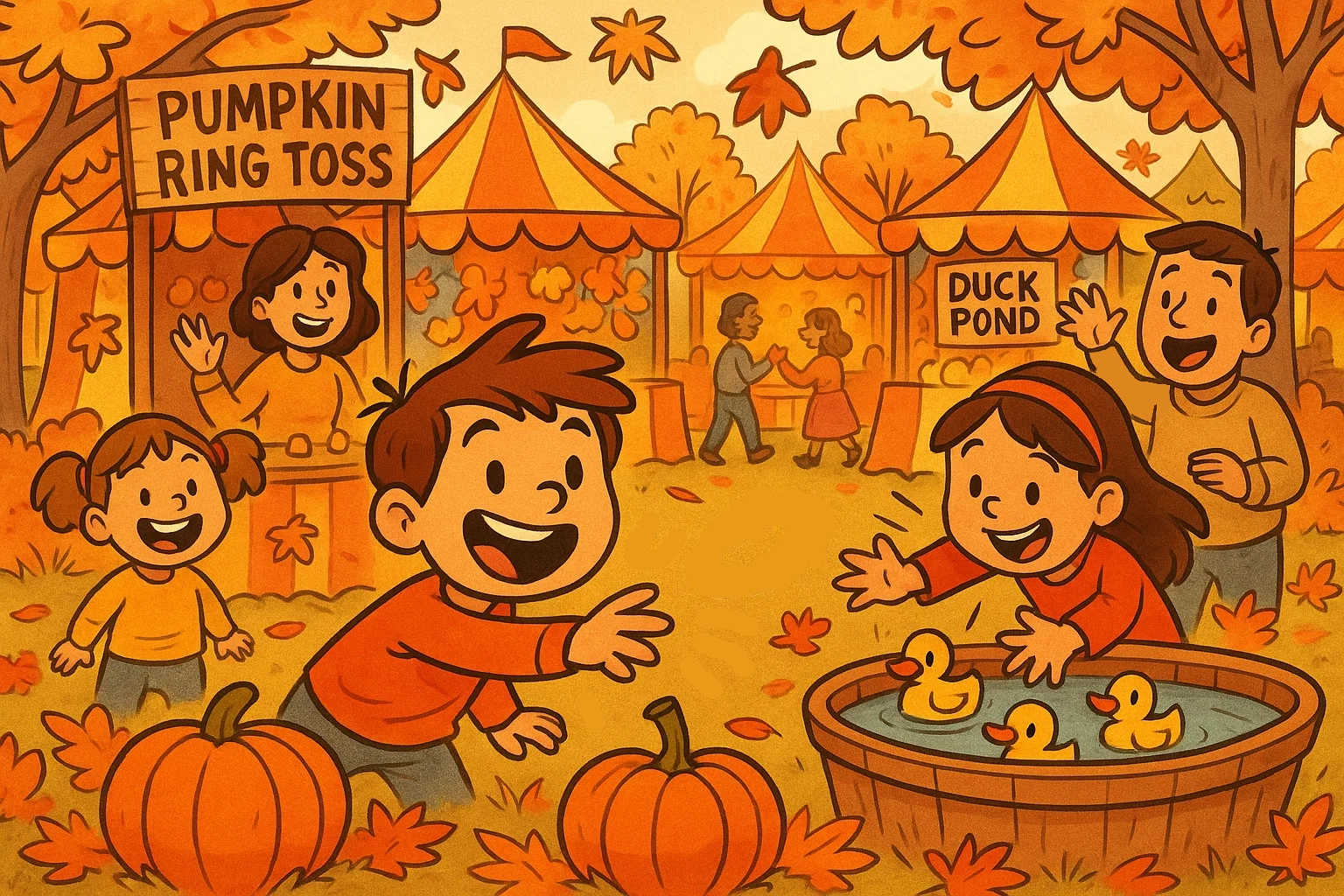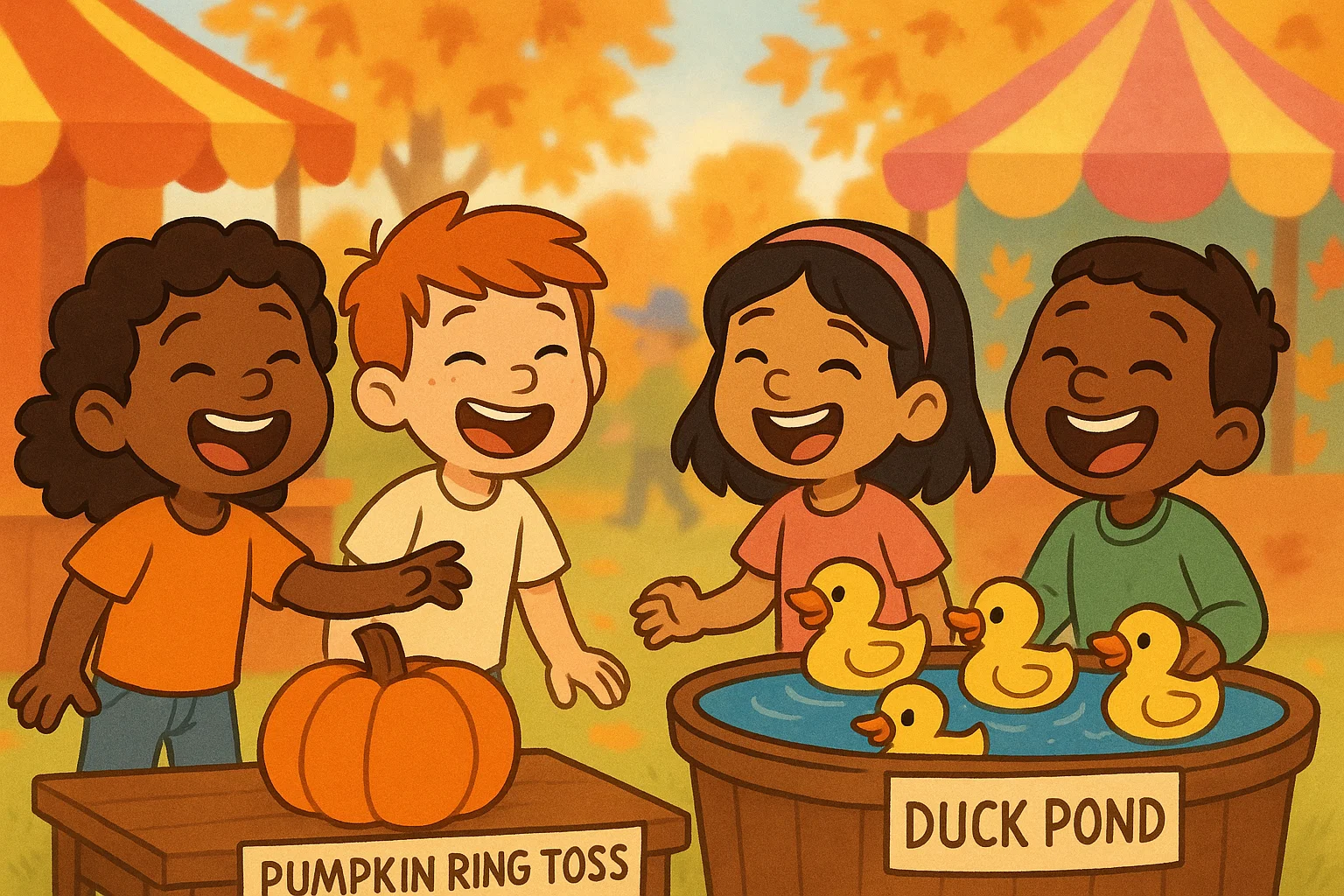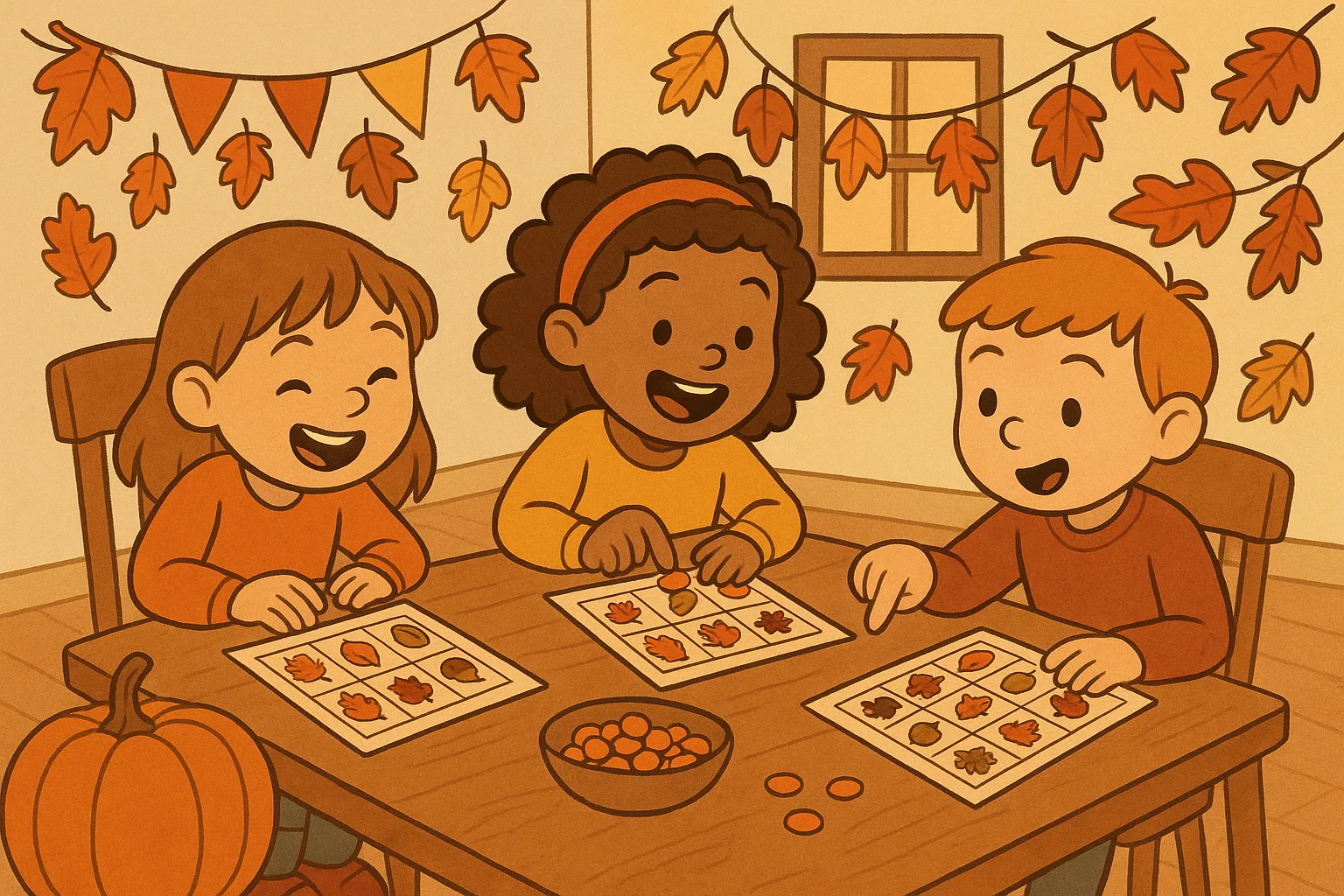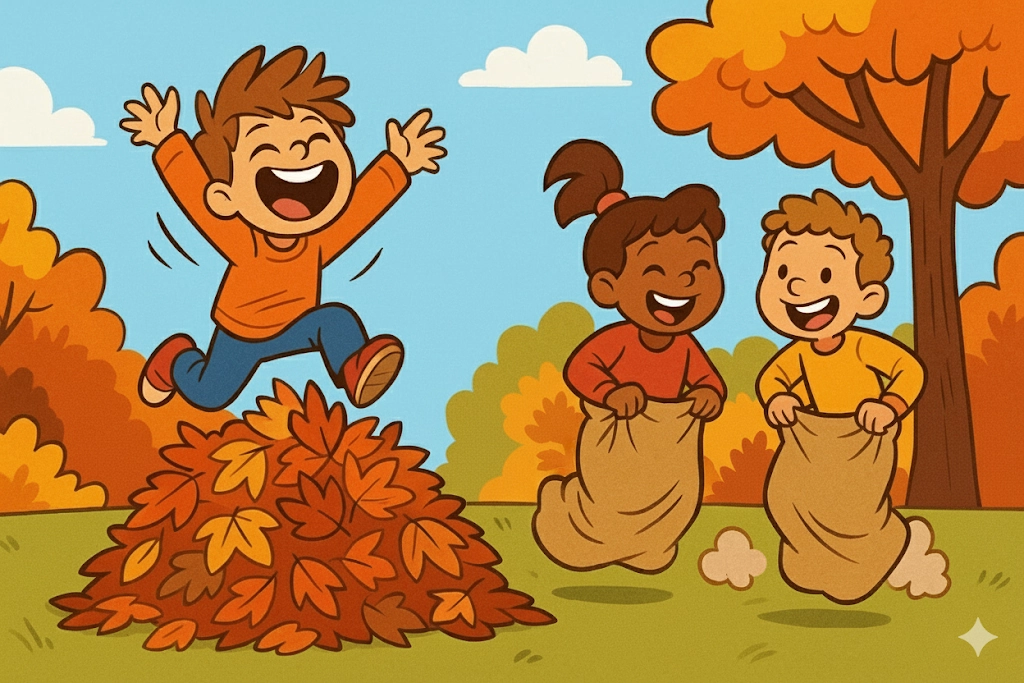Must-Have Fall Festival Game and Activity Ideas

Fall festivals bring communities together with the crisp autumn air, vibrant foliage, and the warmth of shared experiences. Whether you’re organizing a church fall fest, school fundraiser, or neighborhood harvest festival, choosing the right games and activities can transform a simple gathering into an unforgettable event.
The beauty of fall-themed games lies in their versatility. You’ll find options that work for toddlers and preschoolers, engaging activities for older kids, and challenges that bring together kids and adults alike. This guide walks you through must-have fall festival game ideas that create memorable experiences for every age group while keeping your planning practical and budget-conscious.
Classic Carnival Games

Traditional carnival games form the backbone of successful fall events, offering familiar fun with an autumn twist. These activities have stood the test of time because they’re simple to set up, appeal to multiple age groups, and create opportunities for families to play together.
Pumpkin Ring Toss
The pumpkin ring toss takes a carnival staple and gives it a seasonal makeover. You’ll set up real or artificial pumpkins of different sizes at varying distances, then challenge festival-goers to toss rings around the stems. This game works beautifully for young kids who can stand close to larger pumpkins, while older participants can try their luck with smaller targets placed further away.
To create this classic fun experience, you’ll need:
- 5-8 pumpkins in varying heights
- 10-15 rope or plastic rings (6-8 inch diameter)
- A clearly marked throwing line
- Hay bales for decoration and boundary marking
One festival organizer in Vermont noted that color-coding rings by difficulty level increased participation by 40% at their annual harvest festival. Consider using orange rings for easy tosses, red for medium difficulty, and brown for the challenging throws.
Duck Pond
The duck pond game brings nostalgic charm to any fall carnival. Small children especially love this activity because every participant wins a prize, making it perfect for toddlers who might struggle with more competitive games. You’ll float numbered rubber ducks in a small kiddie pool or large tub, and kids use a small net to “catch” their duck.
This game that brings joy to the youngest festival-goers requires minimal setup. Match the numbers on the bottom of each duck to corresponding prizes. According to child development specialists, non-competitive games like duck pond help build confidence in children ages 2-5 while still providing the excitement of carnival participation.
Candy Corn Bowling
Candy corn bowling transforms traditional bowling into a fall activity that kids will love. Paint plastic bottles or use empty 2-liter bottles decorated to look like giant candy corn, then arrange them in a bowling formation. Participants roll a small pumpkin or orange ball to knock down as many “pins” as possible.
| Setup Option | Materials Needed | Best For | Cost |
| Decorated Bottles | 10 plastic bottles, paint, small pumpkin | All ages | $15-25 |
| Weighted Pins | Store-bought bowling pins with fall stickers | Older kids | $30-45 |
| DIY Candy Corn | 2-liter bottles, colored paper, tape | Budget-conscious | $10-15 |
This simple and fun game adapts easily for different age groups. Space the pins closer together for little ones, and increase the throwing distance for teens and adults.
Knock Down Challenge
Stack decorated boxes, tin cans, or foam blocks featuring fall imagery like leaves, acorns, and pumpkins. Players throw bean bags or soft balls to knock down the tower. The knock down challenge works particularly well as a church fall fest activity because it requires minimal space and accommodates continuous play with quick resets.
Research from MDPI on motor skill development shows that throwing activities support hand-eye coordination in children ages 3-10. You can incorporate educational elements by labeling stacks with autumn vocabulary words or simple math problems that kids solve by knocking down the correct answer.
Fishing for Apples
This fall twist on the classic fishing game uses a small inflatable pool filled with floating apples instead of magnetic fish. Participants use small nets or even try to “catch” apples using only their hands, creating an engaging fall festival game that works for nearly every age group.
Set up the fishing station with:
- Large tub or kiddie pool
- 20-30 small apples
- Small fishing nets with handles
- Towels for drying hands
- Buckets for collected apples
One community organizer reported that adding a time challenge element increased the excitement level. Give participants 30 seconds to catch as many apples as possible, then let them keep one apple as a healthy prize alternative.
Indoor Fall Festival Fun

When weather becomes unpredictable or space constraints require moving festivities indoors, these indoor fall festival games maintain the autumn spirit while adapting to smaller venues. Indoor activities also work exceptionally well for school fall festivals held in gymnasiums or classrooms.
Pumpkin Bowling
Similar to candy corn bowling but with a different setup approach, pumpkin bowling uses small decorative pumpkins as bowling balls. The weight distribution of real pumpkins creates unpredictable rolling patterns that add humor and challenge to the game. Set up inflatable pins, stuffed fabric pins, or even decorated paper bags weighted with sand.
This fun activity requires about 15 feet of clear floor space, making it practical for most indoor venues. A study from the National Association for Sport and Physical Education suggests that modified bowling activities help children ages 4-8 develop spatial awareness and motor planning skills.
Fall Colors Bingo
Fall colors bingo transforms the classic game with autumn-themed cards featuring pumpkins, colored leaves, acorns, scarecrows, and other seasonal images. This educational activity works beautifully for preschoolers learning to recognize fall symbols while providing relaxing entertainment for older participants.
Create variations for different age groups:
- Picture-only bingo for non-readers
- Word-and-picture combinations for emerging readers
- Fall trivia bingo for older kids and adults
- Blackout rounds for extended play
Festival organizers report that bingo stations create natural gathering points where families can sit together, making them valuable for promoting community connections at your fall fest.
Pin the Stem on the Pumpkin
This fall-themed spin on “Pin the Tail on the Donkey” requires a large pumpkin poster (or draw one on poster board), blindfolds, and stem cutouts. Blindfolded participants try to place the stem in the correct position, creating laughter and friendly competition.
The game works particularly well in schools because it supports multiple learning objectives. Teachers have incorporated this activity into lessons about spatial relationships, following directions, and even plant anatomy for older students.
Guess the Autumn Scent
Challenge participants to identify seasonal scents like cinnamon, apple, pumpkin spice, nutmeg, and pine. Place different fall scents in opaque containers with holes in the lids. This sensory activity engages multiple learning styles and provides a calm, focused experience that balances more active games.
Include a scorecard where participants write down their guesses, with small prizes for the most correct answers. This game also creates opportunities for families to discuss seasonal memories associated with different smells.
Outdoor Fall Festival Activities

When blessed with good weather, outdoor activities allow you to embrace the full autumn experience. These fall harvest festival games take advantage of natural elements and larger spaces to create the immersive fall atmosphere that makes these events special.
Hay Bale Obstacle Course
Hay bales serve double duty as both decoration and game elements. Arrange them to create an obstacle course where participants climb over, crawl under (using supported planks), weave between, and jump from bale to bale. This physical challenge appeals to energetic kids while providing photo opportunities that help promote your next fall festival.
Design considerations include:
- Safety First: Ensure bales are stable and won’t shift. Place padding or straw around jumping points.
- Multiple Paths: Create easy and challenging routes so young kids and older participants can both enjoy the course.
- Time Trials: Add competitive elements for teens and adults who want a more intense challenge.
- Team Options: Let families tackle the course together, with parents helping little ones through difficult sections.
One school fundraiser committee reported that their hay bale maze generated more ticket sales than any other activity, suggesting that larger physical installations create exciting focal points for fall festivals.
Corn Maze Quest
A traditional fall experience, corn mazes work for various skill levels depending on size and complexity. Small corn mazes suit young kids who might feel overwhelmed by elaborate designs, while intricate patterns challenge older participants. If a full corn maze exceeds your budget or space, consider creating a hay bale labyrinth or using corn stalks to mark pathways in a smaller area.
For churches and schools with limited outdoor space, portable corn mazes made from tall canvas panels decorated with corn stalks offer a practical alternative. These temporary structures pack away for storage and reuse at future fall events.
Jumping in a Leaf Pile
Sometimes the simplest fall activity creates the most joy. Rake leaves into large, soft piles and let kids dive in. This free event element costs nothing but provides pure autumn happiness. Position leaf piles away from hard surfaces, check for hidden objects before children jump, and supervise young kids to ensure safe play.
Consider adding structure by organizing leaf pile relays where teams race to jump into a pile, retrieve a hidden token, and race back. This transforms simple play into an organized game while maintaining the carefree spirit that kids love about fall.
Pumpkin and Sack Races
These races bring classic outdoor fun to fall festivals while incorporating seasonal elements. For pumpkin races, participants push small pumpkins across the ground using only their noses or roll larger pumpkins using their hands. Sack races become autumn-themed by using decorated burlap sacks with fall designs.
Create divisions by age:
- Ages 3-5: 15-foot course with assistance allowed
- Ages 6-9: 30-foot course, independent completion
- Ages 10-12: 50-foot course with obstacles
- Teens and adults: 75-foot course, speed trials
These traditional fall activities work especially well for school fall festivals because they require minimal equipment while accommodating large numbers of participants. One organizer noted that parent-child relay races generated enthusiastic participation and strengthened the community feel of their event.
Food Contests and Stations
Food-based activities combine entertainment with the harvest season’s bounty, creating memorable experiences that engage multiple senses. These stations work for indoor fall festival events and outdoor gatherings alike.
Bobbing for Apples
Apple bobbing remains a must-have fall tradition despite its messy nature. Fill large tubs with water and floating apples, then challenge participants to grab apples using only their mouths. Have plenty of towels ready, and consider providing aprons or old t-shirts to protect clothing.
For sanitary considerations important at any free event or ticketed festival, use individual small tubs for each participant rather than shared water. Some organizers have adapted this by hanging apples from strings at different heights, creating a “bite the apple” challenge that eliminates the shared water concern while maintaining the spirit of this classic game.
Pie Eating Contest
Few activities generate as much laughter and spectator engagement as pie eating contests. Choose fall flavors like apple, pumpkin, or sweet potato pie. The rules typically prohibit using hands, making this inherently messy but undeniably entertaining.
Organize contests by age divisions to ensure fair competition and appropriate expectations. Small individual pies (4-6 inches) work better than large slices because they create uniform portions for all contestants. According to event planning professionals, pie eating contests generate social media sharing at twice the rate of most other festival activities, providing valuable promotion for your next event.
Caramel Apple Bar Station
Rather than a competition, the caramel apple station offers a fun way for families to create edible crafts together. Provide apples on sticks, bowls of melted caramel, and topping stations featuring chopped nuts, sprinkles, mini chocolate chips, crushed cookies, and coconut.
This activity serves multiple purposes:
- Provides a memorable experience families create together
- Offers a take-home prize (the finished apple)
- Accommodates various ages working side by side
- Creates natural photo opportunities
- Generates minimal waste compared to disposable prizes
One church fall festival coordinator noted that their caramel apple station became the most photographed area of their event, leading to increased social media visibility and higher attendance the following year.
Planning Your Next Fall Festival
Successful fall festivals bring together thoughtful planning, community engagement, and the right mix of activities. The execution phase matters as much as selecting games, so consider these organizational strategies.
Tips for a Well-Organized Carnival
Effective planning begins months before your fall festival. Create a timeline that works backward from your event date:
3 Months Before:
- Secure venue and necessary permits
- Form planning committees for games, food, and logistics
- Establish budget and ticket sales strategy
- Begin promotion efforts
6-8 Weeks Before:
- Finalize game selections based on expected attendance
- Purchase or gather materials for diy fall activities
- Recruit volunteers and create schedules
- Design promotional materials
2-4 Weeks Before:
- Conduct volunteer training
- Confirm all vendor and supplier orders
- Create detailed day-of timelines
- Prepare backup plans for weather concerns
Week Before:
- Test all game setups
- Prepare signage and directional materials
- Hold final volunteer meeting
- Organize prize distribution systems
Consider traffic flow when arranging activities. Place the quietest games away from louder attractions, position food stations where smells won’t interfere with activities, and create clear pathways that prevent bottlenecks.
Promoting Your Festival for Maximum Turnout
Getting the word out requires a multi-channel approach that reaches different community segments. Traditional methods still work: distribute flyers at schools, post announcements in local newspapers, and place posters in community centers. However, digital promotion has become equally important.
Social media strategies that generate engagement include:
- Behind-the-scenes setup photos showing your fall-themed games coming together
- Countdown posts highlighting different activities each day
- User-generated content from previous years’ festivals
- Interactive polls asking followers to vote on prize options or activity preferences
- Live videos during the event to capture excitement
Partner with local businesses to cross-promote. A coffee shop might display your festival poster in exchange for recognition as a sponsor. Schools can include information in newsletters and student planners.
Create promotional materials that clearly communicate:
- Date, time, and specific location
- Whether it’s a free event or requires ticket purchase
- Age appropriateness of activities
- Accessibility accommodations
- Weather cancellation plans
Prize Ideas for Fall Games
Thoughtful prize selection motivates participation while staying budget-conscious. Many successful festivals use a tiered approach with different prize values for various games and difficulty levels.
Small Prizes (for games where everyone wins):
- Stickers featuring fall themes
- Small candy items (avoid nuts due to allergies)
- Temporary tattoos with autumn designs
- Pencils or erasers with seasonal decorations
- Small bouncy balls in fall colors
Medium Prizes (for games requiring moderate skill):
- Small stuffed animals
- Activity books or coloring books
- Plastic pumpkin containers filled with treats
- Small flashlights or glow sticks
- Sidewalk chalk sets
Top Prize (for challenging games or contests):
- Larger stuffed animals
- Board games
- Art supply sets
- Gift cards to family-friendly local businesses
- Decorated pumpkins or fall wreaths
Consider non-material prizes as well. Recognition certificates, winner’s ribbons, or photo opportunities with costumed characters can create meaningful memories without increasing costs. One organizer shared that their “Golden Pumpkin Award” photograph station became as popular as physical prizes, with families treasuring the photos years later.
For school fundraisers, consider creating a prize system that supports the school. “Principal for a Day” or “Homework Pass” prizes cost nothing but hold significant value for kids. Church fall festivals might offer special recognition during services or opportunities to help with future events as prizes that build community connections.
